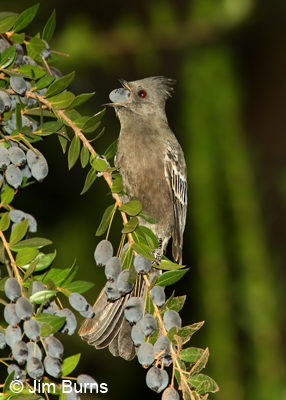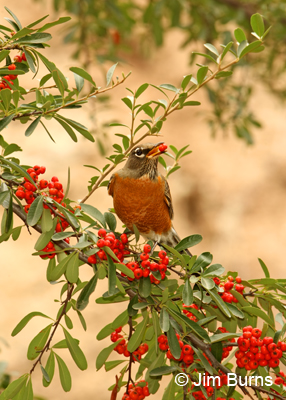
Novice birders quickly learn that birds are habitat specific--no herons or egrets in a mesquite bosque, no cardinals in the flooding furrows of an agricultural field--and soon begin to apply that lesson, especially during spring breeding season, to their search for nesting species in microhabitats such as xeric city parks, manicured golf courses, and tangled riparian floodplains. They then progress to an understanding of things like migrant funnels and migrant traps, watching for hawks along mountain ridges and searching for passerines in green desert oases.
Photographers though, more interested in concentrations of "captive," predictable subjects up close, have refined habitat specificity to a more basic level. Birds have the same life requirements that birdwatchers do--water and food. Nothing concentrates birds and smart bird photographers like desert waterholes in late spring and fruiting trees in late fall, and these seasonal minihotspots are now beginning to attract birders as well. I'm going to leave waterholes for next spring, but right now fall fruit is hanging heavily from a wide variety of trees and bushes and a wide variety of birds is harvesting it.
No place in central Arizona has more fruiting trees, both native and exotic, than Boyce-Thompson Arboretum State Park (BTA), an hour east of the Valley on U.S. 60, just west of Superior. And because BTA lies along a deep canyon cut by Queen Creek and encompasses a wide variety of microhabitats from open and warm upland foothills to shaded and cool riparian bottoms, its trees continue to bear in a progression throughout the season from mid-October to mid-winter.
Late last month two large Chinese pistachio trees in the picnic area hosted five species of woodpeckers, four species of thrushes, and two species of thrashers in addition to common local birds like Northern Cardinal and Northern Mockingbird. Two of the thrushes were unexpected and much sought vagrants to the Arizona birdscape from opposite ends of the continent, Varied Thrush from the Pacific Northwest and Rufous-backed Robin from Mexico. Often every one of these species was in the trees at the same time, gorging on the ripe red berries, filling the soft silence with odd rustlings and the sound of dropped berries hitting the ground.
The fruit lasted about ten days before the rush of birds, birders, and photographers dissipated, but it wasn't long before two(!) Rufous-backed Robins, along with a flock of ever beautiful Cedar Waxwings and several ever exotic looking Phainopeplas (the 'black cardinasl') were discovered coming to the dark purple, oblong berries of a myrtle bush in BTA's Rose Garden. Birders and bird photographers soon followed, and park personnel also observed skunks and foxes cleaning up under the myrtle after hours.
BTA still rocks the flocks and will continue to do so through and beyond the peak of fall color at Thanksgiving as the fruit of date palms at the canyon entrance and pyracanthas, pistachios, and myrtles farther up the canyon ripens. Photographers will be there with their long lenses. You should be there too with binoculars and lunch. Sit for a couple hours and enjoy this special, seasonal avian spectacle in one of Arizona's special places.